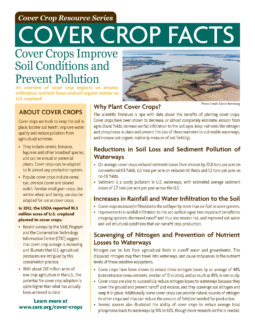Along with cutting costs and increasing crop productivity, cover crops provide various ecosystem services that benefit the environment both on and off the farm. For instance, adding cover crops to a rotation can significantly increase the portion of the year when living roots are present for soil organisms to feed on, which can have a significant impact on carbon sequestration. They also support wildlife and beneficial insects, and protect water quality by playing an important role in nutrient management. SARE’s Ecosystem Services from Cover Crops fact sheets explore the many ways cover crops can maintain soil and benefit the farm ecosystem, including:
- Improving soil conditions and preventing pollution
- Covering the soil to prevent erosion
- Keeping nutrients out of waterways
- Sequestering carbon
- And more!
Check out the fact sheets now.
These free, downloadable and printable fact sheets are an excellent resource for educators, Extension service providers, farmers hosting field days and others. A great overview fact sheet is the “10 Ways Cover Crops Enhance Soil Health,” which addresses the four basic principles for maintaining and improving soil—and how cover crops support those principles.
If you want to dig deeper into the economics and profitability of cover crops, SARE’s newest bulletin, Cover Crops Economics, explores the economics of cover crops in corn and soybean rotations to help farmers answer that big question: “When do cover crops pay?” Download the PDF, view the online version, or order complimentary copies.
